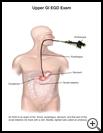
Upper GI EGD Exam
________________________________________________________________________
KEY POINTS
- An EGD is an exam of the upper gastrointestinal (GI) tract. Your child’s provider will use a slim, flexible, lighted tube called an endoscope.
- Your child’s healthcare provider will look for problems such as irritation, infections, ulcers, or abnormal growths. The provider may also take tissue samples or remove growths.
- Ask your child’s healthcare provider how and when you will get your child’s test results and when your child can return to normal activities.
________________________________________________________________________
What is an upper GI EGD Exam?
An EGD is an exam of the upper gastrointestinal (GI) tract with a slim, flexible, lighted tube called an endoscope. The endoscope has a camera on one end so that your child’s provider can see the areas that need to be examined. The upper GI tract includes the throat, esophagus, stomach, and first part of the small intestine (duodenum).
When is it used?
This procedure helps your child’s healthcare provider make a diagnosis. An EGD may be done if your child has ongoing or unexplained:
- Problems swallowing
- Heartburn
- Abdominal pain
- Anemia, which is low red blood cell count or not enough iron in the blood
- Diarrhea
- GI bleeding, which causes your child to vomit blood, or to pass blood that your child may or may not see, in bowel movements
- Nausea and vomiting
- Weight loss
- Abnormal findings on GI X-rays
An EGD may be done as an emergency if your child can’t swallow, has something stuck in his or her throat, or has serious GI bleeding, but usually it is a planned procedure.
How do I prepare my child for this procedure?
- This is usually an outpatient procedure, which means that your child will be able to go home the same day. Talk to your child’s healthcare provider about where your child will have the procedure.
- Your child may or may not need to take regular medicines the day of the procedure. Tell the healthcare provider about all medicines and supplements your child takes. Some products may increase the risk of side effects. Ask the healthcare provider if your child needs to avoid taking any medicine or supplements before the procedure.
- Tell the healthcare provider if your child has any food, medicine, or other allergies such as latex.
- Your child’s provider will tell you when your child needs to stop eating and drinking before the procedure. This helps to keep your child from vomiting during the procedure.
- Follow any other instructions your child’s healthcare provider gives you.
- Ask any questions you have before the procedure. You should understand what your child’s provider is going to do. You have the right to make decisions about your child’s healthcare and to give permission for any tests or procedures.
What happens during the procedure?
Your child will be given medicine that numbs the throat to keep him or her from gagging during the procedure. Your child will also be given a medicine to relax, but he or she may be awake during the test. Your child will be placed on the left side. Your child may have a plastic mouth guard to protect the teeth. Your child’s healthcare provider will insert the endoscope into your child’s mouth and down the food pipe (esophagus). Your child may have a sensation of gas and may feel some pressure from the scope in the stomach.
Your child’s provider will look for problems such as irritation, infections, ulcers, or abnormal growths. Pictures may be taken of these areas. Your child’s provider may also take tissue samples or remove growths. Your child will not feel pain when samples of tissue are removed. Tissue samples will be sent for lab tests. When your child’s provider is done with the exam, the tube will be removed. The procedure usually takes about 10 to 20 minutes.
What happens after the procedure?
Your child will be in a recovery room for about an hour or more, and then can go home. Your child may have a mild sore throat after the procedure.
Ask your child’s healthcare provider:
- How and when you will get your child’s test results
- If there are activities your child should avoid and when she can return to normal activities
- How to take care of your child at home
- What symptoms or problems you should watch for and what to do if your child has them
Make sure you know when you should come back for a checkup. Keep all appointments for provider visits or tests.
What are the risks of this procedure?
Every procedure or treatment has risks. Some possible risks of this procedure include:
- Your child may have problems with anesthesia.
- Your child may have an infection or bleeding.
- Your child’s throat, stomach, or intestine may get torn. If this happens, your child may need surgery.
Ask your child’s healthcare provider how the risks apply to your child. Be sure to discuss any other questions or concerns that you may have.
Last modified: 2021-12-07
Last reviewed: 2020-03-23

